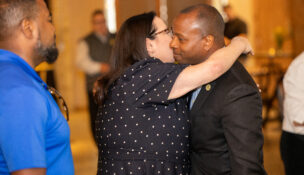Law school scholarship gaps don’t surprise BIPOC groups
By: Bridgetower Media Newswires//June 26, 2024//
Law school scholarship gaps don’t surprise BIPOC groups
By: Bridgetower Media Newswires//June 26, 2024//
By Dan Emerson
In recent years, diversity, equity and inclusion efforts in legal education and the legal profession have helped produce gains for women and BIPOC law students and attorneys. However, African American and Hispanic law students continue to lag behind their white counterparts in receiving scholarships, and also in hiring, according to an American Bar Association survey.
White law students are more likely to land full scholarships and less likely to receive scholarships covering less than half their tuition compared with their non-white classmates, according to the data. White students were awarded 70% of the full-tuition scholarships given by law schools this year but comprise about 61% of the national pool of full-time law students, the new data show.
By contrast, students of color make up nearly 32% of full-time law students but received fewer than 23% of full-tuition scholarships. They were awarded nearly 34% of scholarships worth less than half tuition—a greater share than white law students based on their proportions of the national student pool.
This is the first year the ABA has collected and reported data breaking down law school scholarships by race, though previous research has highlighted racial disparities in scholarship distribution and led to warnings that students from lower socioeconomic groups are subsidizing the tuition of wealthier classmates.
One key reason for the scholarship disparities is schools’ reliance on Law School Admission Test scores, the ABA said. A 2019 study found the average score for Black LSAT takers was 142, compared with 153 for white and Asian test-takers.
The new ABA data also show that Asian law students are significantly less likely to receive full-tuition scholarships than are white students, even though those groups have comparable median LSAT scores. Asians are 7% of law students this year but received about 3% of full-tuition scholarships.
Dana Mitchell, president of the Minnesota Association of Black Lawyers (MABL), said the ABA data is similar to that collected by a national Coalition of BIPOC attorneys groups. “We can only go by what data tells us, and it seems to track with what we know.” As part of the coalition, MABL has participated in data collection “to understand how we are doing with women and people of color both in the private sector and public sector,” she noted.
“The data shows we are making some inroads in the corporate legal world, while not making inroads in some ways; we’ve been rolling back some of the gains we have made in firms,” Mitchell said.
“This is a story we have been telling for a really long time, and the data is not surprising to anyone who has been paying attention; it’s a stubborn problem. We also know that, as a profession we have been losing ground; there are fewer black lawyers than there were 10 years ago. That may be because less aid is going to black law students. But brown and black people don’t want to be on the sidelines.”
“When schools and organizations are offering scholarships, it’s a statement about what they value. We spend money on things we value.”
MABL provides five law school scholarships each year and has been doing so for 27 years, Mitchell said.
Minnesota also has several other ethnicity-based nonprofits that provide scholarships and other support to law students and attorneys. They include the Minnesota Hispanic Bar, Minnesota Native American Indian Bar, and the Minnesota Asian Pacific American Bar. “We are all doing our part to support law students, but we need help,” Mitchell said.
Jerry Organ, Bakken Professor of Law and co-director of the University of St. Thomas School of Law’s Halloran Center for Ethical Leadership, said most law schools use LSAT scores and GPAs as the primary metrics that frame their admissions and scholarship decisions. Organ said the data referenced in the ABA report is consistent with other information generated several years ago by the Law Student Survey Experience Study (LSSE), a research program at Indiana University that has been studying the law student experience since 2004.
“The LSSE data highlights the fact that white and Asian students also tend to come from higher socioeconomic groups. Hispanic and African American students tend to score lower and also tend to be disproportionate among first generation law student population from lower socioeconomic groups,” Organ said.
The LSSSE’s Annual Report for 2016 focused on scholarship differences based on ethnicity and socio-economic status among both first-gen and non-first-gen law students. “The LSSSE Report provides a good explanation of how the devotion law schools pay to LSAT scores drives the differential scholarship experience, because white and Asian students (and students from higher socio-economic communities) tend to have higher LSAT scores and accordingly receive a disproportionate amount of merit scholarship assistance,” Organ said.
In recent years, a declining number of law school applications has motivated many law schools to offer more students financial aid, Organ said. For about a decade, St. Thomas has provided some scholarship aid to every one of its first-year students “to make a modest effort to address the cross-subsidy that happens at most law schools with students with lower entering credentials paying full tuition and effectively subsidizing the scholarships for those with higher entering credentials — as described in the LSSSE Report,” Organ said.
“More scholarship dollars go to more people at the top end of the LSAT and GPA data,” he noted.
Organ said UST wants as much diversity as possible in every class and every metric. “We want [law students and attorneys] to learn from people who are different from themselves. We have gotten better over the last few years and would still like to be better. But we have been improving.”
In a recent interview with Minnesota Lawyer, University of Minnesota Law School Dean William McGeveran said increasing diversity in the legal profession is one of the school’s priorities. “Our student body is a good deal more diverse than it was 10 years ago, and we have to make sure that as we build that community we’re building one that’s inclusive,” McGeveran said. “And you can have the diversity of people’s backgrounds, but if you don’t bring that together in an inclusive way that where everyone gets a benefit from that diversity, then you’ve not finished the job.”
The other law school in the Twin Cities, Mitchell Hamline School of Law, also has a policy of encouraging more diversity, according to a statement from the school.
Legal News
- Milwaukee mayor condemns anti-Semitism, renews calls for justice
- Wisconsin Supreme Court says an order against an anti-abortion protester violated First Amendment
- Prosecutors charge second inmate in assault that left Wisconsin youth prison counselor brain-dead
- Wisconsin Elections Commission rejects recall attempt against state’s top Republican
- ‘Trailblazing’ jurist and civil rights leader sculpture to be unveiled in Madison
- Wisconsin joins coalition urging court to uphold FTC’s ban on deceptive TurboTax advertising
- Marquette Law School Poll survey of Wisconsin finds Biden and Trump tied
- Wisconsin Supreme Court seeks investigation after abortion draft order leaks
- Man sentenced for impersonating a federal officer and wire fraud
- Illinois man rejects deal to plead guilty to 7 murder charges in Highland Park 4th of July shooting
- Wisconsin Court: Man’s Fourth Amendment rights violated
- Judge allows disabled voters in Wisconsin to electronically vote from home
Case Digests
- Suppression of Evidence
- Condemnation Powers-“Pedestrian Way”
- Insurance-Statute of Limitations-Sanctions
- Ineffective Assistance of Counsel
- Ineffective Assistance of Counsel
- Evidence
- Seizure-Reasonable Suspicion-Jury Instructions
- Sentencing Guidelines
- Collective Action-Overtime Wages-Arbitration
- Sentencing Guidelines
- Delayed Disclosure-Mistrial Motion
- Sixth Amendment-Request for Jury Trial












